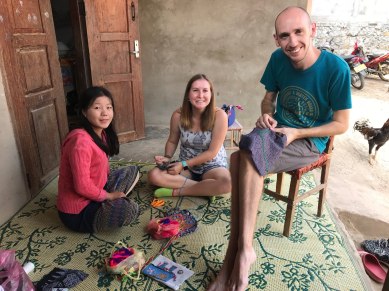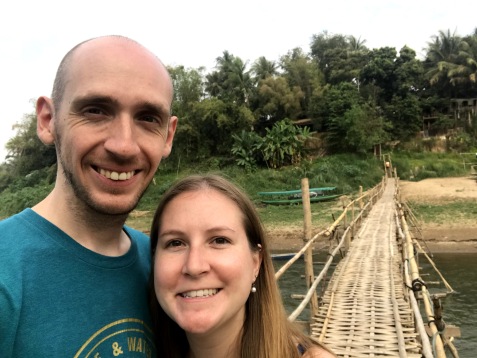Last week Halie had Thursday and Friday off for Makhabucha Day. We decided to use the long weekend to travel to Luang Prabang, Laos. Not knowing much of anything about the city but only hearing great things from friends who’ve been, we we’re excited to see what the mountains and hills of northern Laos had to offer.
As we descended through the surrounding mountains, we could already tell this ancient city bordered by rivers would be different. During the taxi ride to the homestay, a hodgepodge of architecture passed by us. French colonial buildings, wooden homes, temple ruins and thriving monasteries. We quickly checked into our hotel and decided to go explore the city. Right around the corner was the night market so no better place to start.

So if you notice the title of this post, I called Luang Prabang a “dichotomy”. Before I continue with our trip, let me introduce the first part of the dichotomy since it was the first night there that I was confronted with it. Tourist. So many of them. Half the city is 22 year old backpackers. The other half is wealthy, retired Europeans. Initially, it was somewhat of a turn-off to me. Most cities awash with tourists are structured cultural experiences. There’s a facade put in place to appease the masses and hide the authentic nature of the location. This is common across the world and at first glance, I thought Luang Prabang was another casualty.
Until the second day. Using Backstreet Academy, we were picked up by a translator and brought to a Hmong village to learn the art of embroidery with a lady and her daughter. Backstreet Academy is a company that connects travelers with local craftsmen and women to learn traditional techniques of all kinds of things: embroidery, bow making, brewing beer and wine, cooking and woodworking. The list goes on.

Halie and I spent the afternoon embroidering with two Hmong women. They begin learning this craft at the age of 7 or 8 and spend their lives making beautiful clothes and accessories to sell at the night market or use in local ceremonies. After finishing, we walked around meeting some of the other men and women of the tribe and learning about their lives and language and culture.
Let me get back to the dichotomy I was speaking of. I’ve never been to a city that had so many tourist but was so integrated into its own history and culture and local tribes. The night market wasn’t a tourist trap to get our money but a life-line for the Hmong and Khmer tribes surrounding the city to continue the crafts and traditions that they’ve been doing for hundreds of years. The well-kept French colonial structures weren’t a facade but an example of a city that appreciates its architecture and history whether it represents colonization by a foreign power, a powerful tribal king and kingdom or the current communist government.
Okay, back to our trip. Getting back to the city, we began exploring around a bit more.

The city is on a peninsula surrounded by two rivers coming together (Mekong and Nam Khan Rivers). The Nam Khan has a bamboo bridge that is only up 6 months of the year (they take it down for the rainy season). So of course we had to cross it. Who knew on the other side was going to be the greatest meal in my life!?
We were recommended a restaurant named Dyen Sabai by a friend. With benches, chairs and ground level seating all facing the Nam Khan, this place had atmosphere. Reading through the menu, we decided on what the menu called “Lao Fondue,” learning afterwards that this is a popular dish in Luang Prabang called “sindad.” The best way of describing this incredible food experience is a mix between Chinese hot pot and Korean barbecue. You have a pile of hot coals with a grill above. The grill is rounded with a moat for the broth. The meat, vegetables, noodles and eggs all come raw and it’s your job to cook them. Don’t forget to start with the spicy chilis and garlic before adding everything to the broth. Then use the grill to cook the meat (after adding a chunk of fat on top to grease the grill). The broth was the best broth I’ve ever tasted and everything coming out of it was just as good. 
Okay, this is getting too long. Next day, beautiful waterfalls. Afterwards, we walked around to see a few temples and the mountain in the middle of the city. The views were stunning:

Last day, UXO Museum. This intense museum chronicles the 2 million tons of bombs dropped on Laos between 1964 and 1973 and the heroic efforts to locate, dismantle and remove the 80 million unexploded bombs left over from the war. A sobering end to an incredibly enjoyable weekend.
Then flight home. Luang Prabang, when can I return?
To see a few more pictures, check out this Google photos album. Thanks!

💕 Just added this to my bucket list!